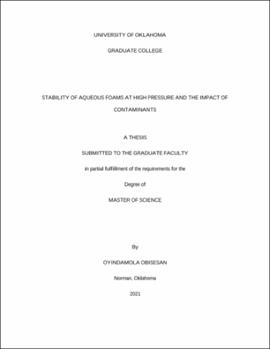| dc.description.abstract | Foam is a mixture of gas bubbles dispersed in a continuous liquid phase that exhibits some form of structure. Foam is used in various oil and gas industry operations such as drilling, cementing, and fracking. The properties of foam that make it applicable for use in the oil and gas industry are its low density and high viscosity. These unique properties make foam applicable in drilling underbalanced while maintaining good hole cleaning and pressure management. However, the thermodynamically unstable structure of foam makes it prone to collapse after a stipulated time based on factors such as the foam quality, base fluid, temperature, and pressure. The half-life of the foam which is the time required for the foam to drain half of its liquid should be sufficient to allow the circulation of foam in the wellbore without significant degradation of relevant properties.
While drilling through various formations, foam can encounter certain contaminants such as salt, oil, clay, and other substances. These substances can change some of the properties of the foam. This study investigates the effect that salt, oil, and clay have on the drainage behavior of the foam. Foam drainage/stability experiments were conducted on the stability of aqueous foams at high pressure (6.89 MPa) and the ambient temperature of 25^oC. The test was performed by trapping the foam in a vertical test section that has 10 differential pressure sensors to measure the pressure profile. Experiments were conducted at the various quality of foam (40%, 50%, 60%) to determine drainage rate and drainage volume at various sections (segments) of the test section for two hours.
The results show that the drainage rate decreases with foam quality indicating that foam stability increases with foam quality. Various contaminants have varying effects on the stability of the aqueous foam. The NaCl and CaCl_2 salts have the effect of improving the stability of the foam at lower salt concentrations. However, at higher concentrations, they destabilize the foam, and this effect is known as the “W” effect of increase and decrease based on salt concentration. The CaCl_2had a higher impact on foam stability due to its greater valency. This behavior was observed across all the qualities investigated.
The effect of mineral oil on the stability of foam is sensitive to its quality. At lower qualities (40% and 50%), foam stability improves with the mineral oil content. But at higher quality, a decrease in the drainage was observed with mineral oil concentration. Both light and heavy crude oils have a destabilization effect on the foam across all qualities. Increasing the concentration of crude oils decreased the foam stability. The heavy oil had a lower destabilization effect than the light crude oil.
The introduction of bentonite and kaolinite clays improved the stability of the foam across all the qualities investigated. Increasing the concentration of clays increased the stability of the foam. Bentonite has a more significant effect on increasing stability than kaolinite. | en_US |
